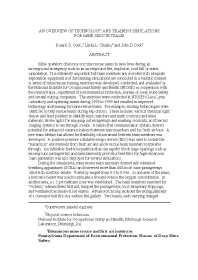Mining Publication: An Overview of Technology and Training Simulations for Mine Rescue Teams
Original creation date: June 1999
Mine operators often rely on mine rescue teams to save lives during an underground emergency such as an underground fire, explosion, roof fall or water inundation. It is extremely important that team members are provided with adequate exploration equipment and that training simulations are conducted in a realistic manner. A series of mine rescue training exercises was developed, conducted, and evaluated by the National Institute for Occupational Safety and Health (NIOSH) in cooperation with the Pennsylvania Department of Environmental Protection, Bureau of Deep Mine Safety and several mining companies. The exercises were conducted at NIOSH's Lake Lynn Laboratory and operating mines during 1995 to 1999 and resulted in improved technology and training for mine rescue teams. For example, existing technologies were identified to help rescue teams during exploration. These included various chemical light shapes and laser pointers to identify team members and mark crosscuts and mine materials, strobe lights for mapping out escapeways and marking crosscuts, and thermal imaging systems to see through smoke. A hands-free communication system showed potential for enhanced communications between team members and the fresh air base. A new team lifeline that allows for flexibility of movement between team members was developed. A positive-pressure inflatable escape device (IED) was used to isolate the "hazardous" environment from fresh air and allow rescue team members to traverse through. An inflatable feed-tube partition that can rapidly block large openings such as underground passageways and simultaneously provide a feed-tube for high-expansion foam generators was also deployed for several simulations. During the simulations, mine rescue team members donned self-contained breathing apparatuses (SCBA) and traversed more than 400-m of mine passageways filled with nontoxic smoke. Visibility ranged from 0.3 to 0.9-m. In one area of the mine, a kerosene heater was used to simulate a fire and reduce the oxygen concentration. In another area, a 1.5 pct methane zone was established. The team members searched for "victims," administered first aid, mapped the passageways, built temporary stoppings, and ventilated the smoke-filled entries. Advanced training included the extinguishment of a conveyor belt fire in a surface fire gallery. Two teams, each carrying charged waterlines, were escorted into the fire gallery through both doors. These teams controlled the rollback smoke and extinguished 7 to 9-m of burning conveyor belt. Team members indicated that the exercises were extremely beneficial due to the realism of the training simulations.
Authors: RS Conti, LL Chasko, JD Cool
Conference Paper - June 1999
NIOSHTIC2 Number: 20027572
28th International Conference of Safety in Mines Research Institutes, Sianaia, Romania, June 7-11, 1999. Pterosani, Romania: National Institute for Mining Safety and Explosion Proof Protection, 1999 Jun; 2:521-538
See Also
- Education and Training
- An Ounce of Prevention: Training Workers to Prevent a Crisis
- An Overview of the Evaluation Process for Mine Trainers
- A Performance Approach to Training Research
- Tell Me A Story... Using Stories to Improve Occupational Safety Training
- Tell Me a Story: Using Narrative to Teach Safety to Skilled Blue-Collar Workers
- Tell Me a Story: Using Stories to Improve Occupational Safety Training
- Tell Me a Story: Why Stories are Essential to Effective Safety Training
- Training Evaluation Tips
- Working in the Classroom - A Vision of Miner Training in the 21st Century
- Page last reviewed: 9/21/2012
- Page last updated: 9/21/2012
- Content source: National Institute for Occupational Safety and Health, Mining Program


 ShareCompartir
ShareCompartir
